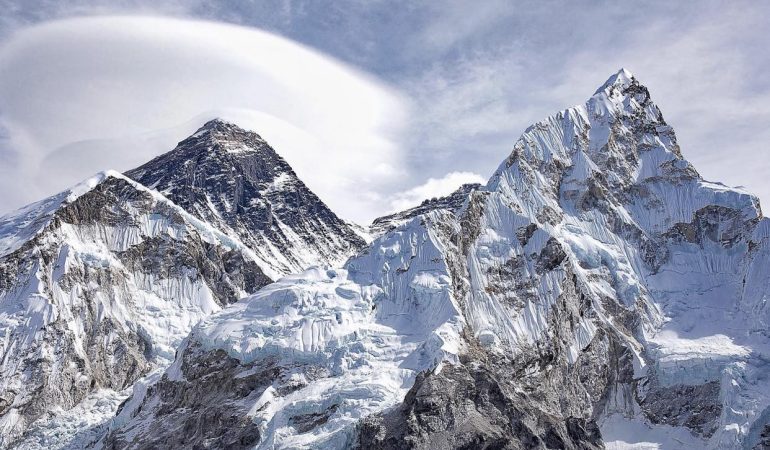
- Home
- /
- Expeditions
Everest Expedition
Everest Expedition [53 DAYS]

Trip Overview
Mount Everest, the highest peak on Earth, stands majestically within the Mahalangur Himal range of the Himalayas, lying along the border between Nepal and Tibet. Standing at an official height of 8,848 meters (29,029 ft) above sea level, it marks the highest point on Earth. Its vast massif is surrounded by other renowned peaks such as Lhotse (8,516 m), Nuptse (7,855 m), and Changtse (7,580 m), making the region a dramatic and breathtaking landscape.
The mountain’s elevation was first measured in 1856 during the Great Trigonometrical Survey of India, which recorded it at 8,840 meters (29,002 ft) and referred to it as Peak XV. Later, in 1865, the Royal Geographical Society officially named it “Everest” in honor of Sir George Everest, a former Surveyor General of India. The widely accepted height of 8,848 meters was established by a 1955 Indian survey and later verified by Chinese measurements in 1975.
Mount Everest remains the pinnacle of challenge and aspiration for mountaineers across the globe. Two primary routes are commonly used: the southeast ridge from Nepal (the standard route) and the north ridge from Tibet. Although the standard route does not involve extreme technical climbing, the expedition is perilous due to harsh winds, unpredictable weather, the risk of avalanches, and the notorious Khumbu Icefall. Tragically, the mountain has also claimed many lives; by 2016, over 200 climbers’ bodies remained on its slopes, some becoming somber markers along the path to the summit.
Detail Itinerary
Day 01: Kathmandu arrival (1,350 m), hotel check-in, and orientation session.
Day 02: Equipment inspection, completion of official permits, and final preparations in Kathmandu.
Day 03: Fly to Lukla (2,860 m), trek to Phakding (2,610 m)—3 hrs.
Day 04: Trek to Namche Bazaar (3,440 m), a scenic 6-hour hike through suspension bridges and mountain trails.
Day 05: Acclimatization in Namche—hike to Everest View Hotel/Khumjung.
Day 06: Trek to Tengboche (3,860 m), a 5-hour journey through forests and suspension bridges, arriving at the famous Tengboche Monastery.
Day 07: Trek to Dingboche (4,410 m), a 6-hour journey through scenic valleys and traditional Sherpa villages.
Day 08: Rest/acclimatization day in Dingboche (short hikes for altitude adjustment).
Day 09: Trek to Lobuche (4,940 m)—5 hrs.
Day 10: Trek to Gorakshep (5,170 m) → hike to Everest Base Camp (5,364 m) → settle at Base Camp.
Base Camp Preparation & Training.
Day 11–15: Rest at Base Camp, climbing training on ice, rope techniques, equipment checks, acclimatization
Rotation Phase (Climb High, Sleep Low)
Day 16: Climb to Camp I (6,065m) → overnight
Day 17: Climb to Camp II (6,400m) → overnight
Day 18: Return to Base Camp via Camp I
Day 19–20: Rest at Base Camp
Day 21: Climb to Camp I → overnight
Day 22: Move to Camp II → overnight
Day 23: Touch Camp III (7,200m), return to Camp II → overnight
Day 24: Descend to Base Camp
Day 25–27: Rest days at Base Camp
Second Rotation (Final Acclimatization).
Day 28: Climb to Camp I → overnight.
Day 29: Move to Camp II → overnight.
Day 30: Ascend to Camp III (7,200 m) using supplemental oxygen and spend the night acclimatizing.
Day 31: Descend to Camp II → overnight.
Day 32: Return to Base Camp.
Day 33–36: Rest, weather monitoring, and summit push preparation.
Summit Push
Day 37: Base Camp → Camp II.
Day 38: Camp II → Camp III.
Day 39: Camp III → Camp IV (South Col, 7,920 m).
Day 40: Summit Day (8,848 m) → return to Camp IV or Camp III.
Day 41: Descend to Camp II.
Day 42: Return to Base Camp.
Return Journey.
Day 43–45: Buffer days built into the schedule to manage potential delays from weather, health, or other unforeseen circumstances.
Day 46: Trek Base Camp → Pheriche.
Day 47: Trek to Namche Bazaar.
Day 48: Trek to Lukla.
Day 49: Fly back to Kathmandu → rest & celebration.
Day 50–52: Contingency/reserve days in Kathmandu.
Day 53: Final departure from Kathmandu.
Trip Includes
- Airport pickup and hotel transfers in Kathmandu.
- Accommodation in Kathmandu throughout the expedition.
- Domestic flights and all ground transportation as per itinerary.
- Meals and lodging during trekking and expedition periods.
- Trekker’s Information Management System (TIMS) registration and Sagarmatha National Park entry fees.
- Everest expedition permit and royalty fees.
- Waste management and garbage disposal fees.
- Permit for satellite phone or walkie-talkie usage.
- Liaison officer’s allowances and accommodation.
- Insurance coverage for expedition staff throughout the climb.
Trip Excludes
- International flight tickets to and from Nepal.
- Travel and personal insurance are not included in the standard expedition package.
- Extra nights’ accommodation in Kathmandu or other locations beyond the scheduled itinerary.
- Emergency rescue or evacuation costs, if required.
- Personal expenses such as alcoholic beverages, snacks, internet, phone calls, laundry, and similar items.
- Personal clothing, climbing equipment, and medical kits.
- Filming and drone permits, if applicable.
- Tips or gratuities for guides, staff, and porters.















